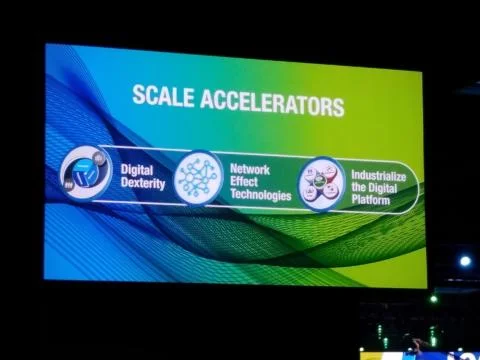“Make no mistake, digital is here. You will take the ride,” declared Peter Sondergaard in his opening keynote at the recent Gartner ITXPO Symposium in Orlando. Sondergaard heads research and advisory for Gartner, and his remarks served as a transformation caution for some IT leaders: "While all enterprises are in for the ride, not everyone will make it through.”
He then outlined three scale accelerators that are key to helping CIOs speed up their efforts to transform – and which set the tone for the Gartner conference this year. Join me as I elaborate on how these scale accelerators manifested themselves over multiple sessions at the event.
“If you don’t like change, you will hate extinction,” as Charlie Feld, winner of the Dallas CIO Leadership Award has said. It still rings true today and aligns with Sondergaard’s observation. Change may not be the goal, but it is inevitable.
[ Get more wisdom from Charlie Feld, in our related article, What it takes to lead IT today: 9 tips from top execs, and in our Q&A, Why a CIO's first 90 days are critical. ]
Enterprises must treat change as a catalyst rather than a combatant. Enterprises must partner with change – as I outlined in my session at the event. And the three scale accelerators can give more meaning to this partnership.
1. Digital dexterity
The word “dexterity” means skill and ease in using the hands. The workforce represents the hands of the enterprise. Sondergaard projected the emergence of the digital employee who will automate many of the routine tasks, with the help of artificial intelligence and machine learning. Thus, digital dexterity is about energizing the workforce with digital resources. Hi there Alexa? Can you talk to Cortana? And, by the way, how are you doing Amelia!
Starting in 2020, AI will be a positive net job creator; eliminating 1.8 million jobs while creating 2.3 million, Gartner predicts. AI, applied wisely, punctuates the relevance of talent.
Kraft CIO Francesco Tinto, in his conference session, estimated one robot to be the equivalent of 2.5 full-time employees – a metric that allows the existing workforce to be more digitally dexterous while innovating on the business of the enterprise. "The future employee is not who or what you think" explained Gartner analyst, Kelsie Marian, discussing retail industry trends.
Talent and culture were called out as key challenges for all top functional leaders including CIOs. The need for diversity across the workforce is vital to foster innovation and overcome bias. Change the technology but extend the people – both human and digital!
2. Network effect technologies
This scale accelerator almost came across as a value-meal of multiple technologies in vogue – Internet of Things, APIs, and artificial intelligence. Let us think about this: Treat your information like an asset – for competitive advantage, said Gartner Analyst and Chief Data Officer, Doug Laney introducing the term Infonomics.
However, information does not appear by magic. Information is obtained by diligent processing of data that matters, making timely connections, and applying the science of analytics. To effect this, APIs serve as the synapses for the ecosystem of IoT. AI drives the behavioral characteristics of this ecosystem.
It is with good reason that these three were packaged into one scale accelerator. “Information” as an asset realizes the most value when all of these three technologies work together. Say hello to a new definition of ROI – return on information!
3. Industrialize the digital platform
A common theme Gartner stressed: Inject new technologies and paradigms, while acknowledging existing investments – whether it be organizations, technology infrastructure, business applications, or human resources. “By 2023, 90 percent of current applications will still be in use,” said Gartner analysts Leigh McMullen and Tina Nunno. Digital transformation is not always a digital replacement of all the informational assets across the enterprise.
Co-existence is key and legacy does not have to be a dirty word. Instead, the focus must be on creating value everywhere with meaningful integration. “Pervasive integration is vital to empowering digital transformation,” said Gartner Vice President and Fellow Massimo Pezzini in his session. Say hello to the Hybrid Integration Platform!
How to avoid extinction
One thing about these three scale accelerators: Contrary to conventional wisdom, these are not accelerators that will get you faster to the mythical end of the digital transformation. Why?
"Top-performing CIOs view digital transformation as a journey" – not a destination, Gartner’s Nunno said. The three scale accelerators effectively position enterprises to keep pace with change during the digital transformation journey.
As Gartner’s Nunno quipped, "You are never done building the digital platform."
Why, you ask? Because you are partnering with change to avoid extinction!







